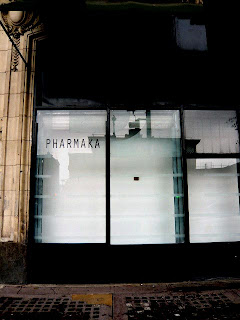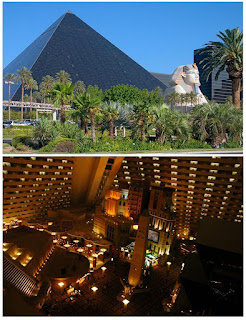
Zahi Hawass, head of Egypt's Supreme Council of Antiquities explaining how Egypt would copyright Egyptian art and antiquities.
“The law would apply to full-scale, precise copies of any museum objects or "commercial use" of ancient monuments, including the pyramids or the sphinx.
“I do not regard the Luxor hotel as a copy of an Egyptian pyramid - the hotel's interior bares little relation to the inside of a genuine Egyptian pyramid.”
Images: top the Luxor hotel in Las Vegas looking just like the pyramids. Bottom the interior – not so much.
Monday, December 31, 2007
Doppelganger
Sunday, December 30, 2007
And the point is….?

Spomenik in Belgrade is a city that came to terms with the man-made pointy sculpture problem many years ago. Here, for cities around New Zealand, and in particular Wellington, a before and after sculptural moment showing how Spomenik shucked off its pointy past.
Image: Top, pointy. Bottom, not pointy.
Posted by
jim and Mary
at
12:07 PM
![]()
![]()
Labels: public sculpture
Saturday, December 29, 2007
Screen stars
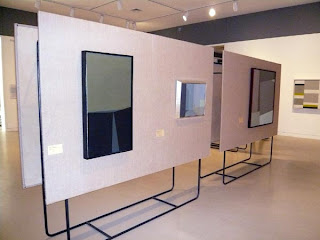
A visit to the exhibition Birth of the Cool at the Orange County Museum of Art brought back memories of Lower Hutt. Say what? In the middle of the show was a section devoted to 1959 with paintings by local artists including the wonderful John McLaughlin, a favourite of Gordon Walters. As you can see, these works were hanging on free standing screens covered with hessian, or burlap as it is known in the US. All that was missing to make the Dowse Art Gallery illusion complete was grey concrete block walls. Only difference was we were still exhibiting on hessian screens in the late, late 1970s, not the 1950s. Tony Fomison’s first survey show was one example. One day someone might do a great essay on the importance of the concrete block and hessian to the display of art in New Zealand from the 1950s to the 1980s.
Image: California Cool at the Orange County Museum, with a McLaughlin painting on the furthest screen.
Posted by
jim and Mary
at
11:17 AM
![]()
![]()
Labels: exhibitions
Santa's little helper
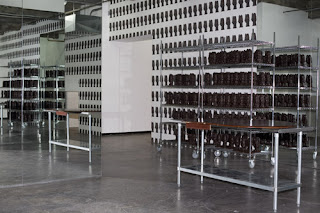
To support our wallpaper trend theory and, we assume to feed our passion for anything that involves chocolate and artist Paul McCarthy, a reader sent us the above photo. McCarthy's chocolate factory in New York plus Santa and Butt Plug wallpaper. Thanks LT
Friday, December 28, 2007
Where did you go me old China?
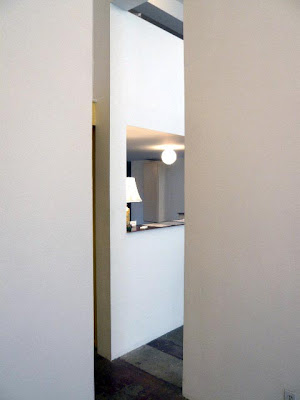
Maybe we didn’t notice the last time we visited, but the new style China Art Objects was a surprise. As we entered by the old door we came up against the classic we’re-very-busy-people counter. We have already posted on the high counter as a cliché of dealer gallery reception areas and now funky old China Art Objects has gone the same way. The two young women hard at work behind it didn’t even know we’d been and gone.
Image: The new counter culture at China Art Objects
Posted by
jim and Mary
at
7:29 PM
![]()
![]()
Labels: dealer gallery
Snap
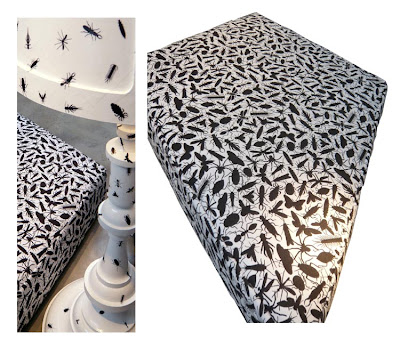
Anyone who has read overthenet for a while will know we’ve featured two series of posts. One is called ‘look alikes’ and the other ‘copy cats’. You can see examples by putting either phrase into the Blogger search. We’ve usually found it easy to categorize with these two headers. Copy cats were just that. People copying other people’s ideas. Look alikes were given the benefit of the doubt. After all, ideas can come from anywhere and most of them aren’t exclusive. You can imagine then the discussion we had when we saw these patterns by the Netherlands design group, Studio Job, at Moss in Los Angeles. If they haven’t seen Richard Killeen’s work and particularly work of the late 70s like Black Crawlers (you can see it here, scroll down when you get to this page), then we’re Dutch uncles. It’s not impossible, just highly, very, almost certainly, probable. So then we wondered if the expression copy cat still makes sense? We’re starting to think maybe not. Perhaps it is all part of the end game of copyright as we know it. You can figure that when corporations are given copyright for colours, for instance Heinz has legal protection for the distinctive turquoise of its cans, that the concept is in its death throws. So we will no longer be using the series header ‘copy cat’. From now on they will all be headed Look alikes.
Image: Studio Job's bug covered lampshade and divan cover at Moss in LA
Posted by
jim and Mary
at
6:07 AM
![]()
![]()
Labels: Look alike
Wednesday, December 26, 2007
Cut and paste
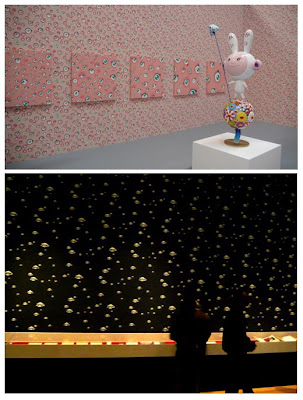
Now that designers splashing computer lettering all over exhibitions has become commonplace, they’ve come up with a new design hazard: wallpaper. Ok, it was fair enough seeing it used in Brisbane’s Warhol exhibition because it followed AW’s own concept for his Whitney show all those years ago. But since then, and we are only talking two weeks we have seen two more wallpapered shows, the Murakami survey at MOCA and Dali and Film at the Los Angeles County Museum. Murakami may well have been tipping his paste brush at Warhol, but the four or five differently papered galleries were about three or four walls too far. As for Dali, he not only got eye wallpaper, he also got his signage made from plastic ants (true). Dead artists can’t speak up, “er, no wallpaper for me thanks” – you’ll have to imagine the Spanish accent – but Murakami should have. It’s just a matter of time for the first artist to get papered in NZ. Who will it be? Richard Killeen must be thanking his lucky stars that he has already been surveyed.
Image: Top eye wall paper at Dali and bottom at the Murakami exhibition.
Posted by
jim and Mary
at
7:04 PM
![]()
![]()
Friday, December 21, 2007
Happy Christmas to you all from overthenet
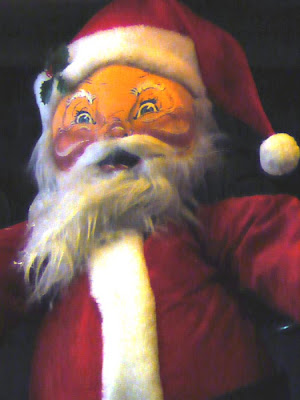
Image: Clifton's restaurant in LA. Mentioned before, but worth repeating.
Posted by
jim and Mary
at
6:25 PM
![]()
![]()
Thursday, December 20, 2007
A night at the movies
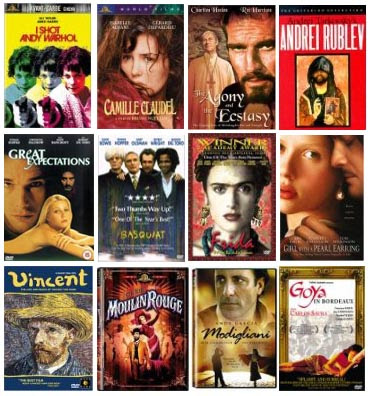
Time to kill? Get down to your local video store or onto Amazon and do an actors-as-artists film festival. Top picks:
Chic flics
Frida. Directed by Julie Taymor
Salma Hayek has the monobrow and director Julie Taymor (Titus and Lion King) is more than up to the visuals. Also features Antonio Banderas, Edward Norton and, inevitably, Geoffrey Rush.
Girl With a Pearl Earring. Directed by Peter Webber
Wow, Scarlett Johansson looks just like the girl in the Vermeer painting.
Fur - An Imaginary Portrait of Diane Arbus. Directed by Steven Shainberg
Nichol Kidman as photographer Diane Arbus and Robert Downey, Jr. as the hairy guy.
Man alone
The Agony and the Ecstasy. Directed by Carol Reed
Charlton Heston is Michelangelo.
Goya in Bordeaux. Directed by Carlos Saura
The sort of movie that film buffs say “rewards patience”.
Rembrandt. Directed by Alexander Korda
Charles Laughton. Amsterdam. 1642.
Camille Claudel. Directed by Bruno Nuytten
Isabelle Adjani plays the women who sacrifices her own talent for her man’s art. This time it’s Rodin (Depardieu).
La Belle Noiseuse. Directed by Jacques Rivette
Michel Piccoli is Edouard Frenhofer. The movie is inspired by the Balzac short story The Unknown Masterpiece.
Pollock. Directed by Ed Harris
Wow, Ed Harris looks just like Jackson Pollock.
Modigliani. Directed by Mick Davis
Andy Garcia is the painter. Unfortunately the memorable line, “Open the door Modi” from the 60s version has been dropped.
Sirens. Directed by John Duigan
Sam Neill is Australian artist Norman Lindsay, Hugh Grant is a minister and Elle MacPherson undresses. One critic described it as "sexy fun".
Andrei Rublev. Directed by Andrei Tarkovsky
205 minutes worth of the famous Russian Icon painter.
Gallery capers
Junebug. Directed by Phil Morrison
The movie about an art gallery owner meeting an outsider artist where you get to see Alessandro Nivola semi-naked and singing.
New York Stories. Directed by Martin Scorsese et al
Nick Nolte plays a middle aged painter called Lionel in The Scorsese segment.
Basquiat. Directed by Julian Schnabel
Jeffrey Wright is brilliant, David Bowie is Warhol and featuring the best after exhibition dinner ever filmed.
The art scene
Moulin Rouge. Directed by John Huston
Jose Ferrer sensibly stays seated most of the time as he plays the diminutive Lautrec. The movie got two Academy Awards, so be warned.
Great Expectations. Directed by Alfonso Cuarón
Dickens’ Pip is transformed to Finn the New York SoHo artist. Clemente supplies the art.
I Shot Andy Warhol. Directed by Mary Harron
Lili Taylor’s Valerie Solanas pops Jared Harris’s Andy Warhol.
The Big Lebowski. Directed by the Cohn Brothers
A performance artist (Marianne Moore) gives ‘tude to The Dude.
Couples
Lust for Life. Directed by Vincente Minnelli, George Cukor
Who looks like Vincent Van Gogh? Kirk Douglas. And Paul Gauguin? That’d be Anthony Quinn.
Vincent & Theo. Directed by Robert Altman, Greg Carson
Through thick (mainly thick) and thin, Tim Roth and someone called Paul Rhys, are the Van Gogh brothers
Posted by
jim and Mary
at
6:14 AM
![]()
![]()
Labels: art in the movies
Tuesday, December 18, 2007
Unlimited edition
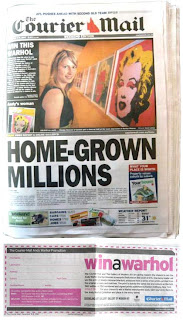
The marketing department of the Queensland Art Gallery must be grinning from ear to ear. In Australia the publicity around the Warhol show has been huge and, a few days after the opening, half a page of photos and commentary by Tom Cardy in the Dominion Post. Cardy was flown over to catch the show by Tourism Queensland and they’ll be pleased with the result. They also scored with Andrew Paul Wood in the Christchurch Press. (You can read his report on the Warhol experience on John Hurrell's blog eyeCONTACT here). One odd initiative associated with the show has been the offer of a Warhol print by Queensland’s Courier-Mail and the Queensland Art Gallery to a lucky punter. Art being the prize isn't the issue, it's just that this particular Warhol print seems to be a giant leap for the authenticity fanatics at the Andy Warhol Foundation for the Visual Arts. Anyone following the Warhol market will know that the Foundation is savage in its protection of Warhol’s authorship and the authenticity of his prints. So to see a Marilyn print offered as “one of ten printed from the original screens and matrixes” is jaw dropping. Warhol used the commercial printer Aetna Silkscreen Products Inc. to produce the original 10 prints of the screened portfolio of which the give-away version is one. They were published in 1967 by Warhol under the name Factory Additions in a closed edition, in this case 250 signed in pencil and numbered with a rubber stamp. Usually, after a numbered run, the screens are destroyed but in this case they can’t have been. Hence the possibility of a posthumous run-on. The ‘prize’ version is of course unsigned and, if this it indicates a loosening of the trousers by the Foundation, many owners of disputed works will be delighted. While this is all certainly in the spirit of Andy Warhol, fancy it now being part of the that’s-one-that’s-not-one approach of the Warhol Foundation.
Quick thinking

Eighteen months, two weeks and three days, almost to the day, CNZ has decided to follow the recommendations of the report it commissioned from Sydney-based company SGS and go to the Venice Biennale. Artists and curators now have twenty-eight days to put in proposals.
Ok, ok. It's more like 58 days. Let's face it, artists and curators don't get to take holidays over Christmas.
"L" COMMENTS "It is under 40 working days which is less time than the visit and report took."
Monday, December 17, 2007
Go figure
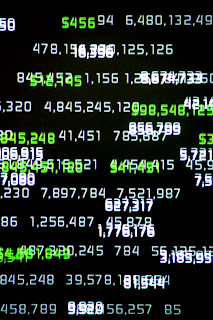
Purchases by Te Papa in the 2006-2007 financial year.
Paintings
14 The number of paintings purchased
78 Percentage that are figurative
78 Percentage painted by men
84 Percentage painted before 1990
64 Percentage painted before 1970
15 Percentage painted in the 21st Century
International
1 The number of International works purchased
1 The number painted by expatriate New Zealanders
Prints
10 The number of prints purchased
10 The number of prints by Marian Maguire
Works on paper
13 The number of works on paper purchased
13 The number produced by men
2 The number of men involved
Drawings
3 The number of drawings purchased
1 The number produced by men
1 The number of men involved
Sculpture and decorative forms
28 The number of sculptures and decorative forms purchased
60 The percentage that are items of jewelry
Photography
162 The number of photographs taken in to the collection
11 The number produced by women
131 The number produced by one photographer
63 Percentage of total donated by a single photographer
Image: Random numbers
If it hits the fan
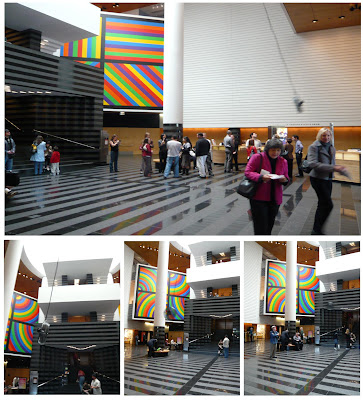
It might be down to OSH, but you don’t often see anything very alarming in our art museums. A spectacular exception would have to be Len Lye’s Trilogy which can scare the bejesus out of anyone who isn’t ready for it. The most extreme version was presented in the National Art Gallery’s Shed 11 where you stood looking straight at the blades rather than down on them, as you usually do at the Govett-Brewster. Someone, maybe it was John Matthews, said that if a blade broke off mid-performance it would simply fall harmlessly to the ground. Hmmm, maybe. Does art have to be safe? Some artists seem to be revisiting ideas proposed decades ago (e.g. by Michael Heizer, Chris Burden) that art with risk might usefully test bureaucratic expectations and shakeup the ennui of visitors. Tate Modern is on the game with the dramatic slides of Carsten Holler’s Test Site (reportedly five injuries) and now Doris Salcedo's Sibboleth. Three people fell into this chasm across the floor of the Turbine Hall on the first day. Some of Simon Denny’s balanced pieces defy the safety rules of most public spaces and just this week we saw a smart example at the Olafur Eliasson exhibition in San Francisco. As you walk into the foyer a large commercial fan swoops down over your head, self-propelled and seemingly arbitrary in its flight pattern. Excitingly alarming but in fact not dangerous at all. So at least some galleries have decided to join with the artists and not play it safe.
Image: Olafur Eliasson’s Ventilator on exhibition at the San Francisco Museum of Modern Art.
Posted by
jim and Mary
at
6:35 AM
![]()
![]()
Saturday, December 15, 2007
Return address
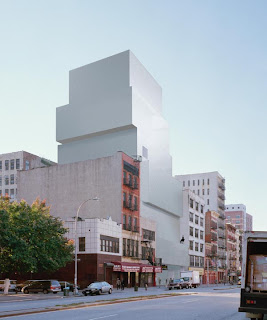
Anyone who visits New York now can get to see the New Museum’s new building on The Bowery. It has been designed by Japanese architects SANAA - Kazuyo Sejima and Ryue Nishizawa. The new New Museum is yet another in a series of destination museum buildings that started with the Guggenheim in Bilbao. If you're wondering why we are telling you this, it's because next to the New Museum is a building that will be recognised by a few of you. It has long been a New York destination for many New Zealanders involved in art: the studio and home of painter Max Gimblett.
Posted by
jim and Mary
at
6:58 AM
![]()
![]()
Friday, December 14, 2007
Over-performing
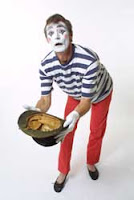
Carla van Zon ONZM is to start work as Manager International at Creative NZ in January. Van Zon was previously Artistic Director of the Wellington International Festival of the Arts (read performing arts). We have mentioned before CNZ's unwillingness to hire staff with specialist visual arts knowledge. This appointment simply adds more weight to this imbalance.
Posted by
jim and Mary
at
1:54 PM
![]()
![]()
Thursday, December 13, 2007
Too much information
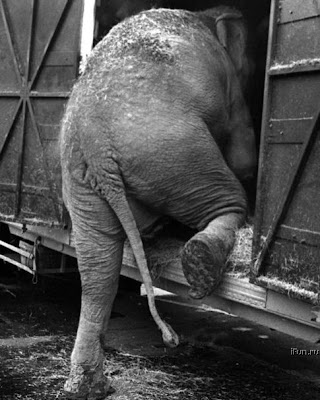
We're about to leave for three weeks in the US and will probably only post sporadically up to the end of the first week in January. From then to the end of January we will be off the grid and will start posting again as usual on 1 February. The best way to be reminded that we are up and running again is to subscribe to the RSS feed. It is on the top of the right hand column of this page. Or, if you'd rather, send us an email and we will send you one back when we start again in Feb.
Posted by
jim and Mary
at
3:00 PM
![]()
![]()
Your tax dollar at work
It’s that time of year again, Te Papa has just released its Annual Report for 2006-07. Here is what the Art staff have published over the last 12 months.
Books: nil
Research publications:
Huddleston: catalogue essay for Hye Rim Lee exhibition at the Gus Fisher.
McAloon: Essay on Gordon Walters in the 5th Asia Pacific Triennial catalogue.
McAloon. Article on the Barr collection in Art and Australia.
Mitchell. Editorial in New Zealand Journal of Photography
Mitchell. Article on photographing the Sutherland Falls in New Zealand Journal of Photography.
Popular: nil
Conference presentations: nil
That’s it.
Forbidden fruit

The web site Strictly no photography encourages people to post photographs taken where you are not allowed to take them. Their Mission is “To organize the world's forbidden visual information and make it universally accessible and useful.” So far they have around 450 photos with about 80 percent taken in art galleries and museums. What is it with art and photography? With modern digital cameras there is rarely need for flash (although someone told us that a museum had recently reported flash didn’t affect art works anyway!) and they are small and unobtrusive. Now that so many museums allow photography in their galleries, the Louvre and MoMA, to name two biggies, why don’t the rest follow suit? What is it that they are trying to protect? The copyright thing is covered by law and practically all the photography in art museums is for personal use – try publishing a photo from a small digital camera working in the subdued light of an art gallery and see how you get on. Getting back to Strictly no photography, the site unfortunately features, along with a mountain of its own we-warned-you’s including ‘terms and conditions’, a ‘privacy policy’ and a ‘use policy’. The caveats include, “You acknowledge that in no way has this Site encouraged, induced, incited or in any other way prompted you to take any photograph where to do so is contrary to any law or legal control in any jurisdiction.” Right.
Posted by
jim and Mary
at
7:19 AM
![]()
![]()
Wednesday, December 12, 2007
Need to know

A picture from a Dan Arps installation taken by Ryan Moore is on the front cover of this months issue of Art Monthly Australia.
Posted by
jim and Mary
at
2:07 PM
![]()
![]()
Labels: need to know
Not to ape the NYT, but...
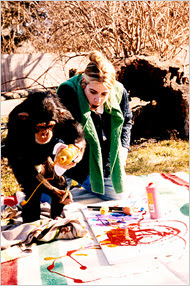
Personally we are all done with painting chimps, but if you want to read about a woman’s fight to start a colony of chimp painters in the Hamptons, go here. Clearly the New York Times still thinks animal art has legs.
Image: Audra Allen in East Hampton with her expressionist chimp, Rickey.
Posted by
jim and Mary
at
12:54 PM
![]()
![]()
Labels: animal art
Never mind the quality, feel the width
 When is an artist’s print not a print? Um… when it’s a printed reproduction. Museums exhibiting the current Bill Hammond exhibition are selling two printed reproductions of paintings in the show, including the signature work Jingle Jangle Morning. Should the buyer beware? Well, here are five different definitions delivered in a single sentence on their web site by the publishers of the reproduction, the Christchurch Art Gallery.
When is an artist’s print not a print? Um… when it’s a printed reproduction. Museums exhibiting the current Bill Hammond exhibition are selling two printed reproductions of paintings in the show, including the signature work Jingle Jangle Morning. Should the buyer beware? Well, here are five different definitions delivered in a single sentence on their web site by the publishers of the reproduction, the Christchurch Art Gallery.
“Well, not the actual artwork, perhaps, but the next best thing – an excellent quality reproduction of a favourite painting. The Gallery Shop has an extensive collection of quality reproduction prints. It includes prints of some of the finest works in the Gallery Collection.”
By the time these two printed reproductions arrive on the internet-prints-for-sale-site www.prints.co.nz they have become “art prints”, “fine art prints” and ”reproduction art prints.”
www.prints.co.nz announces, “We are very excited to have two Bill Hammond reproduction art prints available at last. They are printed in Christchurch by award winning printers Spectrum Print and the colour fidelity of the prints has been personally checked by the artist.”
Superlatives come at a price. The “quality reproduction prints” from the Christchurch Art Gallery are $55.00 each. For one of the “reproduction art prints” via www.prints.co.nz you’ll have to stump up $79.95.
Image: Digital reproduction of a printed reproduction of a painting by Salvador Cherubini of an early Egyptian stone carving of the god Horus who looks like one of Hammond's bird guys.
Posted by
jim and Mary
at
6:57 AM
![]()
![]()
Labels: advice to collectors, xmas shopping
Tuesday, December 11, 2007
Black and white and read all over
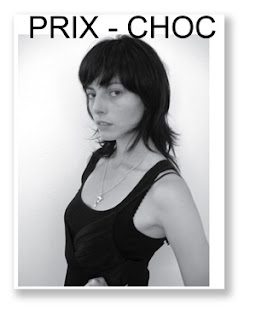
Michael Lett Publishing are up to their tricks again. This time it is a new magazine mysteriously called Prix-choc. The first issue, with its Crockford Pound cover girl, is being launched next Wednesday and promises 244 black and white pages edited by Lett, Moore and Levinson. First issue features Simon Denny, Alex North, Mubarak Ali, and Ricki Levinson. If you must have a copy more than anything else in the world, try the Prix-choc web site.
Lookalike

Every time we Google "Christmas" on the look out for gifts to help you with your shopping, we come across Paul McCarthy’s Santa. This time we also found sinistergreenbunny (yes it’s an inflatable) holding what we can only hope is not a butt plug.
Image: Left, as if you didn’t know. Right Florentijn Hofman Rabbit candybottle
Posted by
jim and Mary
at
2:03 PM
![]()
![]()
Labels: Look alike
Branching out
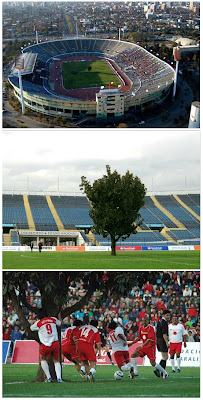
It’s not too late to make Eden Park a great venue for the World Cup - and get some much needed home ground advantage. This 10-meter high magnolia tree was planted by artist Sebastian Errazuriz in the centre of Chile’s National Stadium.
Posted by
jim and Mary
at
7:10 AM
![]()
![]()
Monday, December 10, 2007
Your tax dollar at work
If you want to read John Hurrell reviews there is a new place to go. Up to a month or so ago he was review meister for artbash. How Artbash will cope without the man they call “the Headmaster" is hard to tell, but already there are signs that it is wobbling away from discussing art. John Hurrell was given $10,000 by CNZ and is using it to “assist him in the writing of the articles” which he is posting on a blog called eyeCONTACT. John obviously intends to run a tight ship. “My insistence on proper names is to minimize personal abuse, waffle and shameless self-promotion.” That said, he’s not short on content. In the just four days of operation he’s already posted thirteen of his relentlessly positive reviews. Better get over there quick or you’ll never catch up.
Posted by
jim and Mary
at
9:22 AM
![]()
![]()
Andy down under

The Andy Warhol show in Brisbane’s Gallery of Modern Art (December 8 to March 30) is only 3 and a half hours away and sure has a lot of stuff in it, most from the Warhol Museum in Pittsburg. There are 300 objects including paintings, films, drawing and prints along with a selection of Brillo, Heinz, Del Monte and Campbell’s boxes, wall paper, floating balloons, magazines and the inevitable memorabilia. Although there are some good examples of the early work, the exhibition is constrained by the limited number of first-class examples of Warhol’s output. As a result the exhibition struggles to show why Warhol is considered such an important figure in 20th century art. The black and white Telephone from 1961 certainly demonstrates Warhol grabbing Pop Art by the scruff of the neck, but its prim editing excludes the drips and scumbles of other works of this time, imperfections that Warhol prudently included just in case Abstract Expressionism hadn’t completely run its course. Of more interest are a set of 1961 drawings of newspaper front pages, showing Warhol working his way toward a Pop aesthetic, still with an expressionist drawing hand. A high point is a stunning selection of Warhol’s films, integrated into the exhibition in a way that is bound to be influential on future exhibitions. Duchamp’s screen test is a rare delight, and so too Sleep, the Empire State and Blow Job. One strong endorsement the show makes is that two of its best works are from the collection of the National Gallery of Australia (an acidic Electric Chair from 1967 and a1963 silvery Single Elvis). The Gallery’s inaugural director, James Mollison, instinctively understood that if a national collection is going to be anything more than a pinched provincial experience, it needs to acknowledge the world around it. To see the National Gallery of Australian’s Warhols shining in the company of Pittsburg’s Warhol Museum collections is to appreciate both Mollison’s daring, and Australia’s confident positioning of itself as a citizen of a wider world.
Image: Liza Minnelli helps out with marketing
Saturday, December 08, 2007
Nice bodywork on the Lincoln
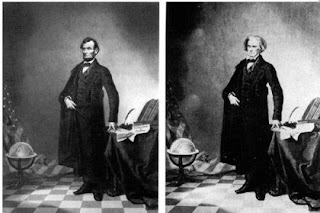
We don’t want to make like the Arnotts biscuit tin lid and just talk about our own posts, but the pics above left is the circa 1860 portrait of U.S. President Abraham Lincoln as constructed out of Lincoln's head and, right, the Southern politician John Calhoun's body. You may remember we referred to this altered photograph when discussing Te Papas Lose-the-Maori banner for their exhibition Tangata o le Moana. Thanks BB.
Posted by
jim and Mary
at
10:19 AM
![]()
![]()
Friday, December 07, 2007
Choc-prix

Continuing with the Christmas spirit on overthenet, a short video to whet your appetite. Paul McCarthy’s chocolate factory in full swing. Christmas gifts galore.
Posted by
jim and Mary
at
4:09 AM
![]()
![]()
Labels: xmas shopping
Thursday, December 06, 2007
Tour guide

The Auckland City Council has certainly made locating Auckland’s public sculpture easy. The City Council has made all the works available on the internet in sensible bite-sized groupings.
Public art
Recently installed work
8 sculptures in the Domain
7 sculptures on waterfront
Current projects
Image: John Pule's mural on Williamson Avenue in Ponsonby.
Posted by
jim and Mary
at
2:31 PM
![]()
![]()
Labels: public sculpture
They’ve got game
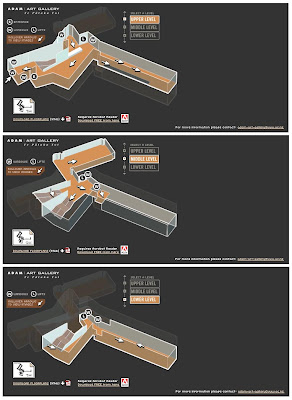
We found what look like screen grabs for Dungeons and Dragons on the Adam Art Gallery site. Not sure how you play but, judging by the arrows, you have to be very careful about which chambers you enter. Some have got reverse arrows to show you how to escape, but from others it looks like there’s no exit.
Click on image to enlarge
Posted by
jim and Mary
at
7:04 AM
![]()
![]()
Wednesday, December 05, 2007
Oh deer

Seriously, the world of sculpture doesn’t get any better than this.
You are looking at a 45m tall, 47m long moose that will hold up to 350 people. It is to be built on the top of Vithatten mountain in northern Sweden. The people of Vithatten are claiming it as the largest moose in the world. Meanwhile, the people of Wellington are asking their Sculpture Trust, “Where’s our moose?”
Posted by
jim and Mary
at
2:27 PM
![]()
![]()
Labels: large animal sculpture, public sculpture, sculpture trust
Stepping up to the plate
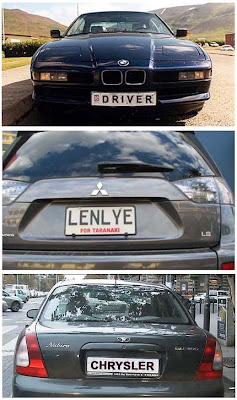
It’s not often you see museum directors promoting local artists, but the Govett-Brewster is wearing its heart on its bumper. One of the number plates above is on the car of Govett-Brewster director Rhana Devenport. An overthenet able tennis ball, signed by an artist of note, for the first right answer*.
*Some conditions apply: staff of the Govett-Brewster and people living in New Plymouth are not eligible.
Posted by
jim and Mary
at
7:40 AM
![]()
![]()
Tuesday, December 04, 2007
Look alike
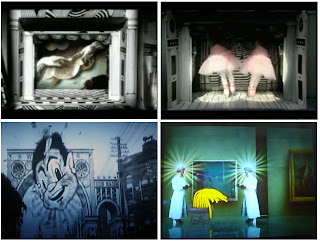
Images: Top, Intro credits to The Southbank Show (you can watch them here). Right, Intro credits to The Big Picture
Posted by
jim and Mary
at
1:12 PM
![]()
![]()
Labels: Look alike
The spirit of the Beecroft

Pietra Brettkelly’s documentary on Vanessa Beecroft The Art Star and the Sudanese Twins has been accepted for the 2008 Sundance Film Festival in the World Cinema section. As far as we know, it is the first New Zealand documentary ever accepted. Brettkelly wrote and directed the film which follows Beecroft as she set out to adopt twin Sudanese orphans. Bringing her famously obsessive personality to the task, American über artist Beecroft tests her marriage and raises questions about “exploitation, culture clash, and the imposition of the West on Africa”. Another of Brettkelly’s documentaries, Beauty Will Save the World, about a contestant in Libya’s first ever beauty competition, screened at the American Film Institute Film Festival in Los Angeles. You can read about her other documentaries here.
Image: Vanessa Beecroft VbSouthSudan
Posted by
jim and Mary
at
7:43 AM
![]()
![]()
Monday, December 03, 2007
Will Elias come to save them?
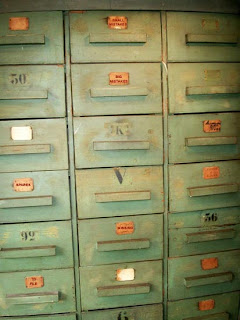
Way back in 1990, we were involved in an attempt to publish a catalogue raisonné of the works of Colin McCahon. For a number of reasons, the main one being the Auckland Art Gallery advising the McCahon family against it, the catalogue was never published and the $50,000 offered by Government never picked up. It was made clear that this was not a job for the private sector. This might seem reasonable in retrospect if we had a catalogue raisonné to leaf through today, but we don’t. Instead we have the Colin McCahon Database and Image Library.
The database was organised by the Colin McCahon Research and Publication Trust and its publication taken over by Te Papa five or six years ago. Each year Te Papa notes in its Annual Reports that it hosts the database and records the number of visits (in 2006 it was 13,454 visits). And each year, in its statement of intent Te Papa claims: “Te Papa Speaks with Authority. All of Te Papa’s activities are underpinned by scholarship ….” So has an exception been made for the McCahon database? It appears to be virtually unchanged since it was first put online.
So what's it like? Around 1600 works are included with basic catalogue details. The quality of many of the images is poor with some badly cropped and damaged. The search function is primitive with a search by year, for example, delivering not only the art works for that year but every work that has a bibliographic reference for that year. You can only be thankful that there are so few bibliographic references. The functionality is very limited. It is not possible for instance to compare two works on the same screen. A section promising essays "on Colin McCahon's life and work" has been empty since its inception.
Of more concern in a database published by a national institution like Te Papa, are the many errors that undermine the credibility of the project and certainly compromise any claims to scholarship.
A random selection:
cm001244 A painting for Uncle Frank is credited as being in a private collection. In fact it is in Te Papa’s collection, and has been since 2004.
cm001709 is titled Crucifixion with MacPalene. Unfortunately MacPalene was unable to be at the crucifixion, they probably mean Mary Magdelene.
cm000073 is titled A vessell(sic)... ('Prayer for the Second Coming' Peter Hooper). The (sic) is inappropriately pedantic for this level of scholarship, and unnecessary as Vessel is spelt correctly by McCahon on the painting.
cm000512 is titled As there is a constant flow of light we are born into a pure land (McCahon to Shadbolt). The painting is inscribed by McCahon ‘Shadbolt from/McCahon’
cm000002 and cm001220 are in fact the same painting recorded with two different unique numbers.
Some questions. Why has Te Papa had responsibility for the database for so long, and left it in such a amateurish state? How do they reconcile their commitment to scholarship with this project? Has the database in fact been abandoned and was never intended to be a growing resource for research? Is Te Papa even able to correct the many mistakes in the database?
Te Papa should either put in the resources needed to make the database the tool it should be, or take it off line and hand it over to another institution willing to make a serious and professional commitment.
The Colin McCahon Research and Publication Trust is credited on every reproduction of a work by Colin McCahon and The Trust’s name fronts the database along with a list of its members. So you might also ask what are they doing about the database? They are: Julian Miles (Chairman), Victoria Carr and William McCahon (McCahon family), Chris Saines (Auckland Art Gallery), Dr Seddon Bennington, Jonathan Mane-Wheoki (Te Papa), Trish Stevenson.
Saturday, December 01, 2007
Legs eleven

In November we: were shocked at Te Papa swapping out a Maori • kept plugging away at getting information from CNZ • played footsy with McCahon and Rothko • began our Christmas gift list with a Santa holding a chocolate butt plug • ruminated over artist publication fees • wondered what it was about men, tv shows and the history of art • questioned the authenticity of an Apple • commiserated with Celia Dunlop • put a bit of colour into the Guggenheim • questioned the Hammond exhibition lighting • realised it has already taken CNZ two and a half years to decide whether or not to go back to Venice • celebrated being 1 year old • kept on with the rabbit thing
Posted by
jim and Mary
at
11:16 AM
![]()
![]()
Outlook for Thursday on Saturday
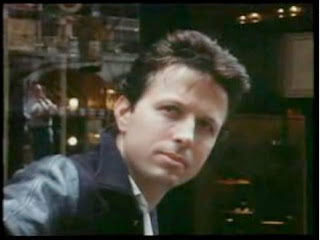
A great song by a great band with enough of an art connection to sneak it on overthenet. Outlook For Thursday by DD Smash. Thanks for that R.
Image: DD Smash Guitarist, Gary Langsford
Posted by
jim and Mary
at
8:30 AM
![]()
![]()
Friday, November 30, 2007
bud and mule go adventuring
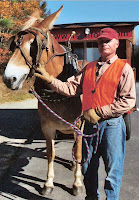 On June 22, 2001 Bud and Patricia Kenny with their mule Della left Hot Springs, Arkansas to tour the world on foot. Bud and mule fanatics can follow this copy cat couple’s trials and tribulations here.
On June 22, 2001 Bud and Patricia Kenny with their mule Della left Hot Springs, Arkansas to tour the world on foot. Bud and mule fanatics can follow this copy cat couple’s trials and tribulations here.
Image: bud and mule
Jeff Koons’ lighter side
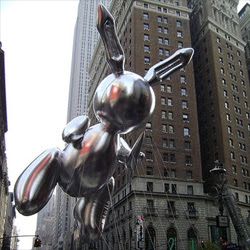
Big rabbits always get a look in on overthenet, and big inflatable rabbits are guaranteed a mention. This year’s Macy’s Parade in New York featured a 16 meter-tall helium balloon version of Koons’s Rabbit filled with 132 cubic meters of helium. So Rabbit has now journeyed from its original inflatable form as a toy, via the stainless steel art version and back to an inflatable again. Here’s another rabbit sighting sent in by a reader. Thanks J.
Posted by
jim and Mary
at
8:10 AM
![]()
![]()
Thursday, November 29, 2007
More on Man
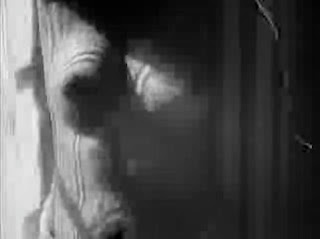
This interesting note from Roger Horrocks, Len Lye’s biographer, on the Man Ray video posted last week. “Not sure if you know Man Ray's account of this film. He says he was shocked to discover that Tzara had announced a Dada evening that would include a film by Ray -- but Ray had only a few film sequences ready. The programme was scheduled for the following evening. How to make a film in a day? He decided to create some rayogram strips to round out the film. Salt and pepper formed the basis of one strip, and pins and thumb tacks another. Ray says he had no idea how such strips would look on the screen until they were projected; but he decided that it would all be over so fast, it didn’t really matter. He combined them with the other sequences and screened them under the title ‘Return to Reason’. Unfortunately Ray had not yet learned how to splice film properly, and the film broke twice, producing howls from hostile members of the audience! All very Dada.”
Image: Man Ray’s model Kiki makes a guest appearance in La retour à la raison
... and on the table

Our first item on 70s artist, David Mealing, was posted at this time one year ago today.
Posted by
jim and Mary
at
9:24 AM
![]()
![]()
Eat my dust

June 2005 et al. exhibits at the Venice Biennale.
“Is it worth being here? Without a shadow of a doubt.” Peter Biggs, Chairman of Creative NZ reporting from Venice. (read report here)
5 months
November 2005 CNZ commissions an $80,000 evaluation report from Sydney-based company SGS,on New Zealand’s participation in the Venice Biennale. (get report here)
7 months
May 2006 SGS’s Report is released and enthusiastically recommends continued New Zealand presence at Venice.
“This evaluation has provided both qualitative and quantitative evidence highlighting that the Venice investment is a worthwhile one.”
“New Zealand will return to the Venice Art Biennale in 2009 as part of a wider international market development strategy” CNZ Chief Executive Elizabeth Kerr (read full statement here)
5 months
October 2006 CNZ calls for nominations for the Tripofalifetime Tour. Selected representatives of the art world will be paid to visit art event hots spots in Europe and report back.
7 months
June 2007 The tripofalifetime tour visits Venice, Basel, Munster and Kasel.
2 months
August 2007 Tripofaliftimers tour members submit their reports to CNZ marked “Confidential”. “our International Market Development Strategy for the Visual Arts.… is to be finalised and presented to the Council of Creative New Zealand for approval at their December 2007 meeting” (CNZ email 26 July 2007)
4 months
December 2007 A discussion about “a strategy on International participation” including the Venice is “on the agenda” for the December meeting of CNZ’s Arts Council. (CNZ email 27 Nov ember 2007)
“Creative New Zealand is planning to release the “overarching Europe delegation report following the Council's December 2007 meeting” (CNZ email 27 November 2007) plus an “up-date regarding the visual arts international strategy” (CNZ email 28 November 2007)
1 month
January 2008 It is planned for CNZ’s new “International team” to be “up and running”.
However CNZ is “not expecting to present a final strategy to the Arts Council until the new International team is up and running.” (CNZ email 27 November 2007)
10 months
November 2008 Or sometime after the election. Our pick for a final decision.
Posted by
jim and Mary
at
6:56 AM
![]()
![]()
Wednesday, November 28, 2007
Missing you already
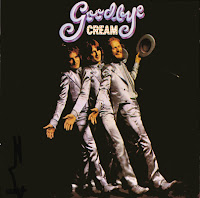
We have just heard the Roger Williams Gallery has closed. A brave attempt, a terrific space and nice people.
Posted by
jim and Mary
at
1:44 PM
![]()
![]()
Tuesday, November 27, 2007
Like a pig in muck
 Hany Armanious, who showed recently at Michael Lett and the City Gallery has been reviewed by Roberta Smith in the New York Times. You can read the review here. Smith thought the show Year of the Pig Sty at Foxy Production in New York’s Chelsea “conveys an impressive sculptural ease and an appealing, provocative bit of let-it-rip madness.”
Hany Armanious, who showed recently at Michael Lett and the City Gallery has been reviewed by Roberta Smith in the New York Times. You can read the review here. Smith thought the show Year of the Pig Sty at Foxy Production in New York’s Chelsea “conveys an impressive sculptural ease and an appealing, provocative bit of let-it-rip madness.”
Image: Year of the Pig Sty on show at Michael Lett in Auckland
Posted by
jim and Mary
at
2:41 PM
![]()
![]()
Not a light touch
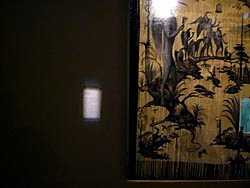
There was a time when theatrical lighting in museums was left to ethnic objects. The idea was to imbue the objects with some sort of museumised spirituality - a “smell of the jungle” as critic Thomas McEvilley once put it. A few museums have clung to this style, Te Papa is one example, but most have left it behind them and display different cultural objects in the same even light. So it was a surprise to visit Bill Hammond’s exhibition Jingle Jangle Morning in Christchurch and see many of the painting displayed in a darkened gallery glowing against black painted walls. Dramatic? Certainly, but it does raise the question of why. The dark room approach is not created for conservation or for optimal viewing of individual works. Its aim is to give a very specific and loaded experience that reaches for high contrast and the dissolution of detail. For some reason Hammond work appears particularly susceptible to this dramatizing. Lighting exhibitions is not as easy as it looks. We remember watching the expert from the Guggenheim Museum lighting the exhibition Masterpieces from the Guggenheim Museum at the Dunedin Public Art Gallery. His objective was to show the paintings without drawing attention to the lighting in any way. His horror, he told us, was to see photographs of exhibition hangings where the works were displayed in halos of light. While he worked he constantly took test photographs to ensure he was getting even light across walls and paintings. The City Gallery in Wellington is now showing Jingle Jangle Morning and they have ratcheted the drama up another notch. Their innovation has been to cut the shape of the light to the shape of the canvas. This has the odd effect of making many of the paintings look
like light boxes. It also makes them hard to see, your irises constantly opening and closing as they are forced to switch back and forth between brightness and gloom. Basic optics warn you that this is no way to light things you want to study at any length. The gloom also badly effects the readability of the labels which, except for the one pictured above (almost comically lit like a painting itself) are tough to read. The other galleries showing work in Jingle Jangle Morning, have been lit more conventionally so there is the opportunity to see the work under more traditional conditions. How the paintings given the grand opera treatment were selected is anyone’s guess.
Image: Hammond (detail) with specially lit label
Posted by
jim and Mary
at
7:21 AM
![]()
![]()
Monday, November 26, 2007
Saving face
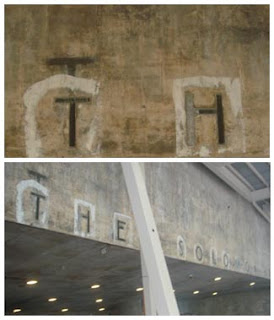
While don’t want to be seen obsessing over the Guggenheim in New York, one of our readers sent this very interesting link to the Design Observer discussing the type face on the Museum’s façade. Besides which it lets us show you these two beautiful photographs by Chris Kasabach of the type, and at least one false start, revealed when the paint was stripped back. Thanks DF
Posted by
jim and Mary
at
11:57 AM
![]()
![]()
Any colour as long as it’s grey

Way back in April we posted a beautiful drawing showing the cracks that had been located in the surface of the Guggenheim Museum in New York. Since then the building has been repaired, repatched and is now ready to paint. But what colour? For months now colour swatches have been hanging on one of the Museum’s walls for the public to look at. Lloyd-Wright’s original buff yellow was painted over in 1992. It's looking like the pale grey-white that was used then, will be used again.
Images: OTN options
Posted by
jim and Mary
at
7:14 AM
![]()
![]()
Saturday, November 24, 2007
War paint
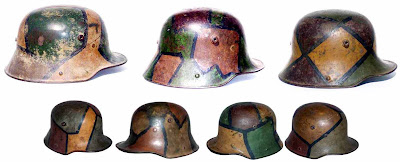
About a year ago we pointed readers to the book Disruptive Pattern Material. Since then it has been on almost full-time loan (popular book) so not sure if these stunningly painted First World War German helmets were in it or not. Anyway here they are, some Head Art for a Saturday.
